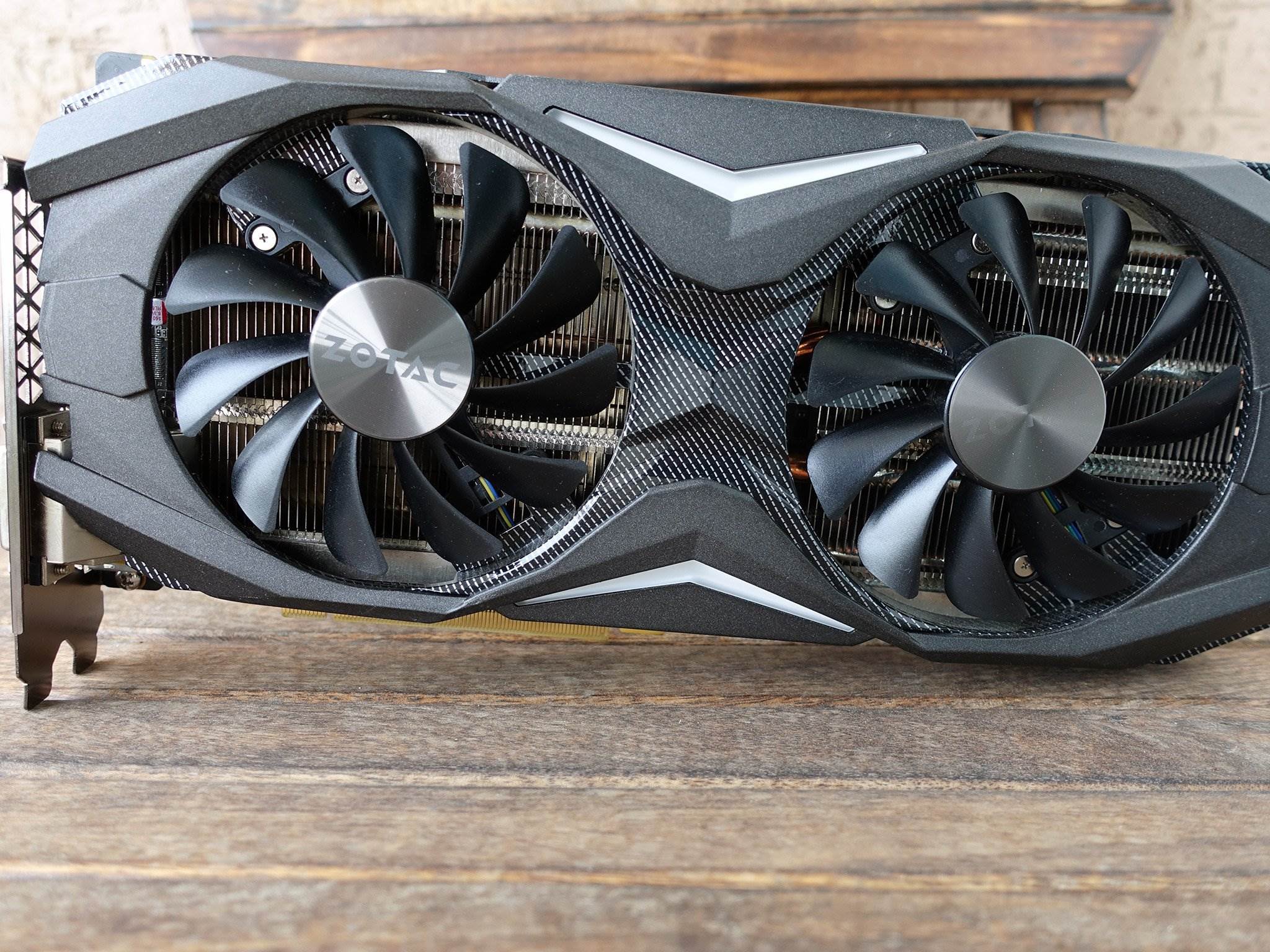After being on the 28nm process for four years, NVIDIA finally made the transition to the more efficient 16nm node with Pascal earlier this year. The shift allowed the chip vendor to include more transistors in the GPU, while leveraging massive energy efficiency gains at the same time. The result is that the GTX 1080 — the current flagship — is not only significantly faster than last year’s Maxwell cards, it does so while consuming less power.
A quick rundown: the GTX 1080 has more CUDA cores than the outgoing GTX 980 (2560 vs. 2048), and also sees an increase in the TMUs to 160 (from 128). The amount of VRAM has also doubled to 8GB, and while yields of the next-gen High Bandwidth Memory are not yet adequate for a mainstream card such as the GTX 1080, NVIDIA went with Micron’s GDDR5X standard. GDDR5X increases memory clock to 10GHz, resulting in a massive boost in the total amount of bandwidth. Over the 256-bit memory interface on the GTX 1080, we’re looking at a memory bandwidth of 320GB/s. In contrast, the GTX 980 maxxed out at an effective 224GB/s.
Pascal overview

Before we delve into the architecture, here’s a look at what’s changed from the GTX 900 series:
| GTX 1080 | GTX 1070 | GTX 980 | GTX 970 | |
| CUDA Cores | 2560 | 1920 | 2048 | 1664 |
| Texture Units | 160 | 120 | 128 | 104 |
| ROPs | 64 | 64 | 64 | 56 |
| Core Clock | 1607MHz | 1506MHz | 1126MHz | 1050MHz |
| Boost Clock | 1733MHz | 1683MHz | 1216MHz | 1178MHz |
| Memory Clock | 10Gbps GDDR5X | 8Gbps GDDR5 | 7Gbps GDDR5 | 7Gbps GDDR5 |
| Memory Bus Width | 256-bit | 256-bit | 256-bit | 256-bit |
| VRAM | 8GB | 8GB | 4GB | 4GB |
| FP64 | 1/32 | 1/32 | 1/32 | 1/32 |
| TDP | 180W | 150W | 165W | 145W |
| GPU | GP104 | GP104 | GM204 | GM204 |
| Transistor Count | 7.2B | 7.2B | 5.2B | 5.2B |
| Manufacturing Process | TSMC 16nm | TSMC 16nm | TSMC 28nm | TSMC 28nm |
| Launch Date | 05/27/2016 | 06/10/2016 | 09/18/14 | 09/18/14 |
| Launch Price | MSRP: $599 Founders $699 |
MSRP: $379 Founders $449 |
$549 | $329 |
The GTX 1080 features NVIDIA’s GP104 silicon, which is manufactured on a 16nm node at TSMC. The GPU offers 7.1 billion transistors on a die size of 314 mm². That equates to more transistors on a smaller die size than last year’s Maxwell series. The core architecture, however, is the same. Pascal still has four GPCs that connect to the memory interface and PCI-Express 3.0 x16 through eight controllers. Each GPC has five streaming multiprocessors (SMs), and each SM in turn consists of 128 CUDA cores. That’s how you get to 2,560 CUDA cores in total. Other specs of the GP104 include 160 TMUs and 64 ROPs.
One key difference from Maxwell is the core clocks. NVIDIA has significantly tweaked the GPU design with Pascal, resulting in base clocks in excess of 1600MHz and boost clocks of 1750MHz. With overclocked editions of the GP104, it isn’t hard to hit 2.0GHz with air-based coolers.
As is the case with every new generation, Pascal introduces a slew of new technologies aimed at virtual reality. That’s the goal with Simultaneous Multi-Projection, which takes a scene and processes it through 16 projections from a single viewpoints. Essentially, if you’re gaming using three monitors in surround mode, the edges will no longer be distorted. Same goes for lens distortion on a VR headset. The feature will need to be enabled by game developers, and while it’s still in its infancy (there aren’t any games that offer it yet), Unity and Unreal Engine added support for it a few months ago.
Then there’s Ansel, which lets you take in-game screenshots, add effects, and publish to social platforms directly. The GTX 1080 also includes native support for 12-bit color palette, as well as 10-bit and 12-bit HVEC video decoding at 4K.
Zotac GTX 1080 AMP! Edition

Zotac has carved out a name for itself in this segment thanks to its AMP! series of factory overclocked cards. The variant we’re taking a look at today — the Zotac GTX 1080 AMP! Edition — offers a base clock of 1683MHz, a decent increase over the 1603MHz on the reference GTX 1080 cards.

The GTX 1080 AMP! Edition (I’m just going to call it the GTX 1080) features a dual-slot design, and is made out of metal. The card definitely looks premium, and the grey paint scheme with a big yellow stripe at the back differentiates the card from the rest of the 1080s available. I like the color scheme, but it won’t be to everyone’s tastes. Given the dual-slot design, the card has a sturdy metal backplate that makes sure it doesn’t sag.

At the front, the metal fan shroud interspersed with the plastic carbon detail gives the card added durability. Zotac went with two 8-pin connectors for the GTX 1080, with a maximum power draw of 375W. Some of the added power is for the lighting scheme called Spectra, which has customizable RGB lighting. You can let the card “breathe,” or use a series of effects according to your preferences.

The card has five heatpipes that siphon heat away from the silicon, and an aluminum fin stack aids in dissipating excess heat. The GTX 1080 comes with two 100mm fans that are silent when the card is idling, minimizing the noise. They’ll whir into action only when a specific temperature threshold is hit (usually about 45 degrees Celsius), or when you initiate a game. When you’re doing everyday tasks like browsing the web, the card stays absolutely silent. On a related note, I’ve been using the card for nearly a month, and I haven’t heard any coil whine.

Overall, the build quality on Zotac’s GTX 1080 is excellent, and it definitely is one of the better 1080s you can pick up today. When it comes to connectivity, you get a DVI port, an HDMI port, and three DisplayPorts (certified 1.2, ready for 1.4) that can run 4K content at 120Hz or 5K at 6Hz. You can even drive 8K at 60Hz by utilizing two ports. The card offers HDMI 2.0b, making it compatible with HDR video.
Zotac has a higher-tier card dubbed the GTX 1080 AMP! Extreme, which has the company’s watercooled Arctic Storm solution. The card needs to be added to an existing liquid cooling loop, so if you don’t have a liquid-cooled setup, the GTX 1080 AMP! Edition is a better bet. There’s also a cost differential to consider. The GTX 1080 AMP! is now available for $629 (down from $670), and the GTX 1080 AMP! Extreme is available for $689. That’s less than the $699 asking price of the reference Founders Edition, and if you’re looking for the most bang for your buck, you’ll want the GTX 1080 AMP! Edition.
Benchmarks
Here’s the configuration of the test system:
– Intel Core i5 4690K CPU
– Noctua NH-L9x65 CPU cooler
– ASUS Z97 Pro (Wi-Fi ac) motherboard
– Corsair Vengeance DDR3 RAM (2 x 8GB)
– 256GB Samsung Evo 840 SSD
— Zotac GTX 1080 AMP! Edition
– Corsair RM850
– ASUS 28-inch PB287Q 4K monitor
– Windows 10 64-bit
– NVIDIA GeForce driver 375.95
Thanks to Zotac for furnishing the video card for review.
Batman: Arkham Knight

Battlefield 1
Crysis 3

Fallout 4

Grand Theft Auto V
Hitman

Titanfall 2

The Witcher 3: Wild Hunt

As is evident from the benchmarks, the GTX 1080 — and Zotac’s variant in particular — is aimed squarely at 4K, and while it doesn’t necessarily hit 60fps in all titles, it certainly does a much better job than last year’s GTX 980.
Verdict

For $639, there really isn’t a video card that comes close to the Zotac GTX 1080 right now. The card is one of the most affordable 1080s in the market, and it hits the sweet spot between affordability and great feature-set. The card isn’t as energy-efficient as the reference design Founders Edition, but you get more bang for your buck. The build quality is excellent and the lighting scheme is interesting, but most importantly, the GTX 1080 is designed to crush benchmarks. It manages to do just that.
You’ll be able to pick up the Zotac GTX 1080 AMP! Edition in Singapore for S$979, which comes out to the equivalent of $686. If you’re looking for a GTX 1080 that costs less than the reference design and manages to deliver a high-quality cooler, easy overclocking options, and a noise-free experience for everyday use, just get the GTX 1080 AMP! Edition already.











